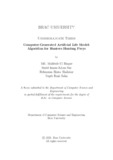| dc.contributor.advisor | Kaykobad, M. | |
| dc.contributor.advisor | Kaykobad, Tanvir | |
| dc.contributor.author | Haque, Md. Mahbub-Ul | |
| dc.contributor.author | Sur, Surid Imam Khan | |
| dc.contributor.author | Shahriar, Rehnuma Binta | |
| dc.contributor.author | Saha, Supti Rani | |
| dc.date.accessioned | 2022-03-09T09:58:32Z | |
| dc.date.available | 2022-03-09T09:58:32Z | |
| dc.date.copyright | 2021 | |
| dc.date.issued | 2021 | |
| dc.identifier.other | ID 17201117 | |
| dc.identifier.other | ID 18101421 | |
| dc.identifier.other | ID 18101428 | |
| dc.identifier.other | ID 18101156 | |
| dc.identifier.uri | http://hdl.handle.net/10361/16438 | |
| dc.description | This thesis is submitted in partial fulfillment of the requirements for the degree of Bachelor of Science in Computer Science and Engineering, 2021. | en_US |
| dc.description | Cataloged from PDF version of thesis. | |
| dc.description | Includes bibliographical references (pages 60-61). | |
| dc.description.abstract | This thesis simulates the behavior of predators and preys observed between a pack
of wolves and a deer herd during a hunting scenario. We use the Boids flocking
algorithm, an artificial life model developed by Craig Reynolds to simulate the deer
herd. We have also enriched the existing algorithm to help flocks recognize their
surroundings, like their neighbors and predators, and react accordingly. The pack of
wolves has a leader, and they coordinate as a group isolating a deer from the herd and
then capturing it. To implement the predator’s behavior and intelligence, we have
developed some algorithms applying their hunting procedure. A part of the research
is to explore simple rules that the wolves can follow to achieve their hunting goals.
We have also worked on the concept of the Convex Hull algorithm, that can help
the predators define their attack positions. Interruptions in the hunting environment
between prey and predators that affects the actions of preys and predators have also
been studied. In this experiment, actions by the prey and predators are compared
in terms of realism. | en_US |
| dc.description.statementofresponsibility | Md. Mahbub-Ul Haque | |
| dc.description.statementofresponsibility | Surid Imam Khan Sur | |
| dc.description.statementofresponsibility | Rehnuma Binta Shahriar | |
| dc.description.statementofresponsibility | Supti Rani Saha | |
| dc.format.extent | 61 pages | |
| dc.language.iso | en | en_US |
| dc.publisher | Brac University | en_US |
| dc.rights | Brac University theses are protected by copyright. They may be viewed from this source for any purpose, but reproduction or distribution in any format is prohibited without written permission. | |
| dc.subject | Simulation and modelling | en_US |
| dc.subject | Boids | en_US |
| dc.subject | Flocking | en_US |
| dc.subject | Predator | en_US |
| dc.subject | Prey | en_US |
| dc.subject.lcsh | Artificial intelligence | |
| dc.subject.lcsh | Computer algorithms. | |
| dc.title | Computer-generated artificial life model: algorithm for hunters hunting preys | en_US |
| dc.type | Thesis | en_US |
| dc.contributor.department | Department of Computer Science and Engineering, Brac University | |
| dc.description.degree | B. Computer Science | |

